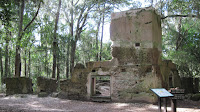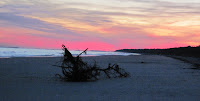

The first words I thought of to describe Hilton Head Island prior to planning a trip there were:
Expensive
Rich and famous
Golf
There is so much more to the island than what those words can describe. So much so I will make a post for each of the words I now think of to relate to Hilton Head Island such as:Golf,History,Environment,Food,Rich and famous,
Beach***in no particular order of importance. It took some doing to get here. We ran into an unexpected snow storm in our travels and altered our accommodations on the way down as a result. Hubby's booked his golf around the weather and our site seeing also revolved around the weather. Thankfully I got lots of pictures to share with you BEFORE the camera broke. This is very upsetting to me. The camera is new, only a few months old. I'm hopeful it can be returned when we get back home.
The island is relatively new...new in terms of what we all think of that is. The vacation spot, the golfers paradise haven't been around all that long. Electricity only got to the island back in 1950 so you can see what I mean.
The short history is the area was initially inhabited by Native American tribes, then the Spanish arrived (back in the 1500's). The Spanish mistreated the natives and were ousted by them. Along came the English, Captain William Hilton in search of land to grow sugar cane and indigo. Plantations flourished.
The Island was over run with Union forces during The Civil War, Confederate prisoners, and escaped slaves. After the war, the island was all but abandoned. The crops were destroyed by the Boll Weevil and the people who remained were escaped slaves and their descendants. They fished and farmed in isolation; not being connected to the mainland. They developed their own language and culture based on their African heritage. It wasn't until 1940 the island was re-discovered by wealthy sportsmen, who saw the commercial potential of all the Pine Trees. In 1950 electricity hit the island and in 1956 the bridge connecting it to the mainland made transportation to and from the island more accessible; thus the period of tourism began in earnest. Charles Fraser's family owned a large portion of the island (specifically the area now called Sea Pines). He was a lover of nature and forward thinking with development. Though the island is commercialized, and highly developed; it is done so with protectionism for the land in mind. Buildings, signs, lights etc. all must meet a strict environmental standard. Large areas of land are put aside as a preserve for the birds, alligators and turtles. Even lights from the hotels are regulated during important nesting times.
The island is 12 miles long and 5 miles wide, with lots of bike trails, beaches, golf courses, and nature preserves. Charles Fraser is buried under an Oak Tree on the island he so loved. Much is still being learned about the Gullah culture (the culture of the slaves and their descendants), which no doubt will add to what we know about Hilton Head Island.
The photo's show our less than pleasant drive here, and the cloudy beach when we first arrived.

 Traveling by train. Yes, actually I've done that. Some years back in Canada with a group of 14 on a ski trip. We did have a sleeping compartment, and...oh wait. That's a post for another time. lol Today, we're traveling by train...Thomas The Train. Look at the expression, he is most certainly traveling somewhere in his imagination. This cutie LOVES all things related to trains and can tell you all the names of Thomas The Train's friends. We hadn't gotten to give him his Christmas presents until a few nights ago.
Traveling by train. Yes, actually I've done that. Some years back in Canada with a group of 14 on a ski trip. We did have a sleeping compartment, and...oh wait. That's a post for another time. lol Today, we're traveling by train...Thomas The Train. Look at the expression, he is most certainly traveling somewhere in his imagination. This cutie LOVES all things related to trains and can tell you all the names of Thomas The Train's friends. We hadn't gotten to give him his Christmas presents until a few nights ago. This fun large puzzle show's Thomas The Train chugging along, and the flip side of the puzzle can be colored. How cool is that? So cool, he decided hanging upside to show his excitement was a good idea.
This fun large puzzle show's Thomas The Train chugging along, and the flip side of the puzzle can be colored. How cool is that? So cool, he decided hanging upside to show his excitement was a good idea. Even coloring, it's hard to catch still enough to get a picture, thus the blur. The special wipe off crayons come with the puzzle.
Even coloring, it's hard to catch still enough to get a picture, thus the blur. The special wipe off crayons come with the puzzle.























